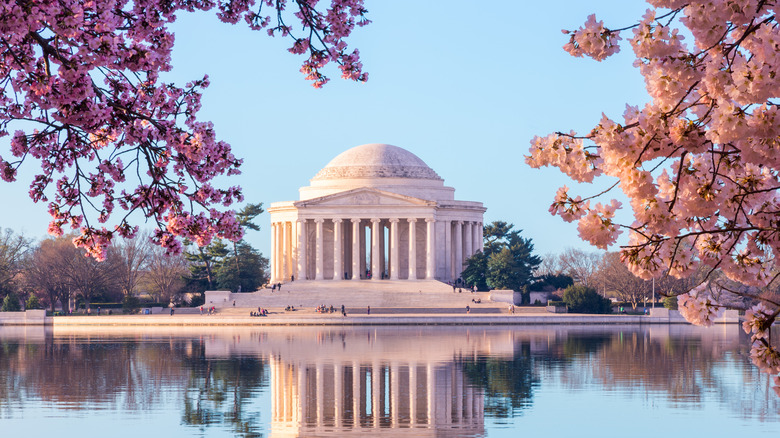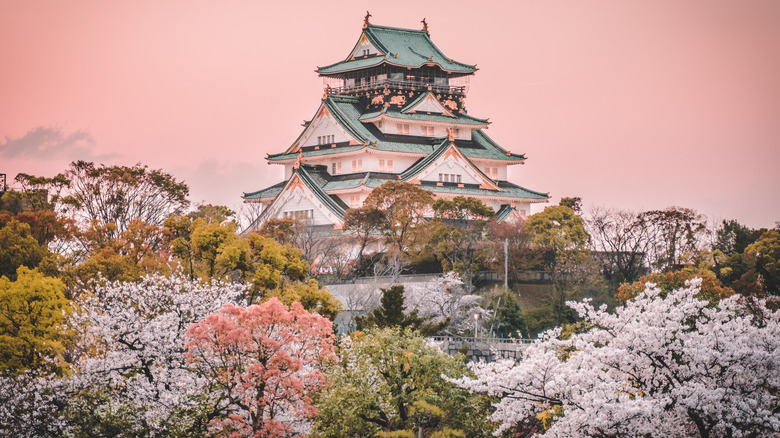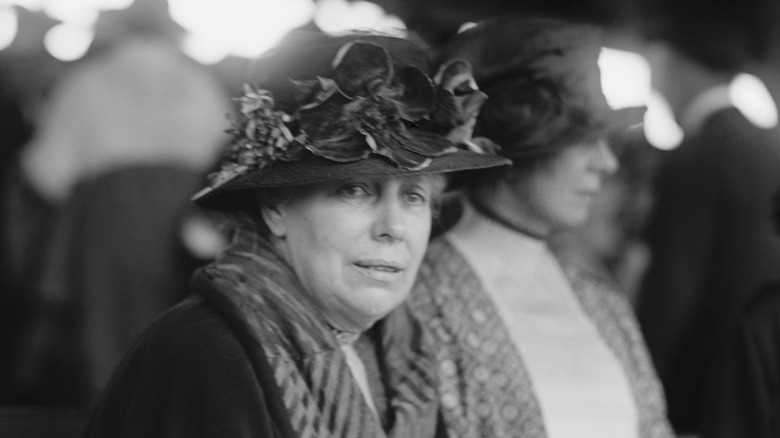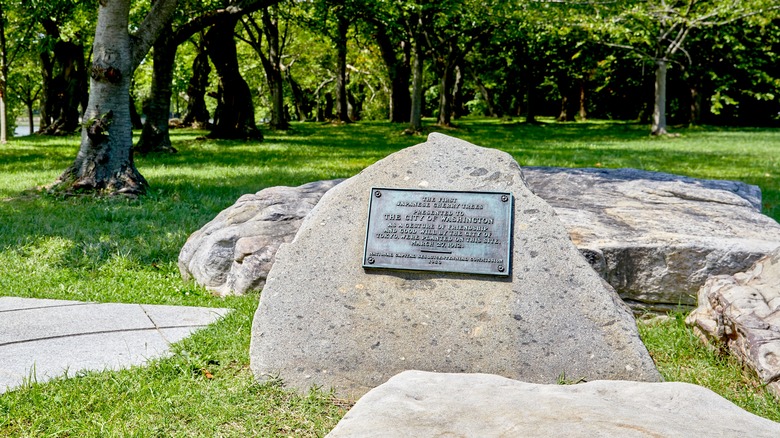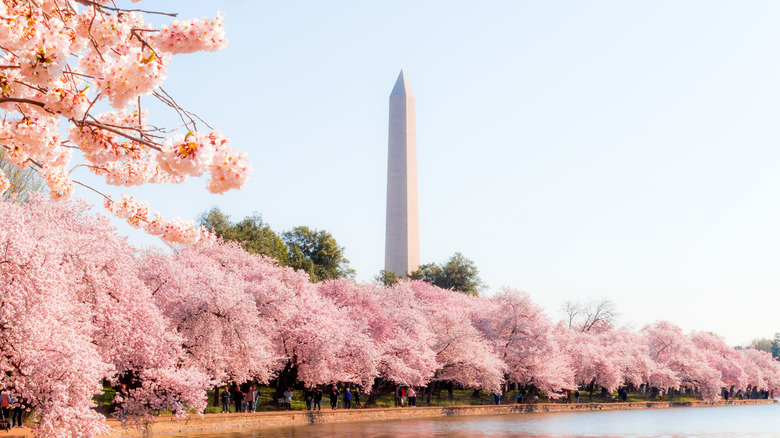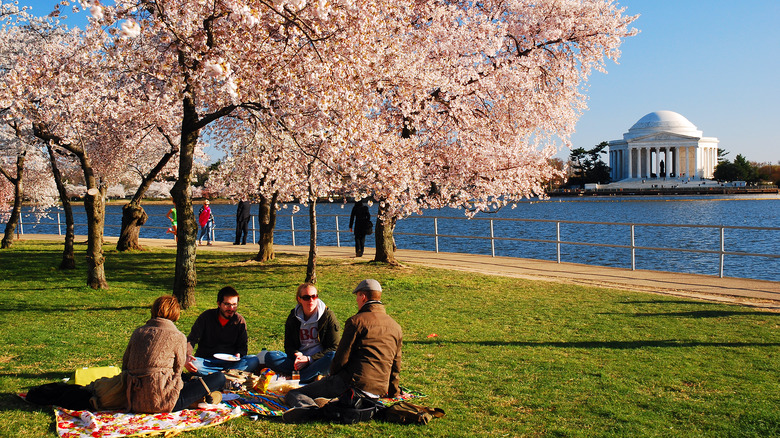The History Of Washington D.C.'s Famous Cherry Trees Explained
Cherry blossom trees, also known as sakura, hold a significant meaning in Japanese culture, and they feature prominently in the country's history. Each year, millions of tourists flock to Japan to witness the beauty of the light pink flowers that bloom during the cherry blossom season that lasts just a few weeks each year sometime between March and April (via The National News).
In Japan, cherry blossom trees represent the impermanence of life, just like the flowers of the tree that stay in bloom for a brief period. According to the Brooklyn Botanic Garden, cherry blossom trees are integral in spirituality. Furthermore, they were symbolic of the life of samurais, who lived short but meaningful lives. Cherry blossoms were also used as an insignia on the kamikaze pilots' planes during World War II. Cherry blossom trees are also considered a symbol of friendship between Japan and the United States. In 1912, the country of Japan presented the U.S. thousands of cherry blossom trees to plant in Washington, D.C.
Eliza Scidmore and Dr. David Fairchild's efforts
Eliza Scidmore was a traveler, author, and journalist who was one of the board members of National Geographic. In 1885, Scidmore traveled for the first time to Japan where she took great interest in the Japanese culture. She saw the beauty of the cherry blossom trees and wanted to share it with the people of the United States (via National Park Service). When she returned to Washington, D.C., Scidmore approached the Army Superintendent of the Office of Public Buildings and Grounds and proposed the idea of planting cherry blossom trees in Potomac Park, but it was refused. Scidmore described cherry blossom trees as "the most beautiful thing in the world," and she was intent having them in Potomac Park. She persisted and presented the idea to superintendents over the course of more than 20 years, but still, they were not interested.
Meanwhile, Dr. David Fairchild, a plant explorer for the Department of Agriculture, was looking for ways to introduce the cherry blossom trees in the U.S. He imported different types of cherry blossoms from Japan in 1906 to see whether they would thrive in the environment. Dr. Fairchild planted the trees on his property in Maryland and observed how they grew; it was a success. Scidmore and Dr. Fairchild talked about their common goal of planting cherry blossom trees in the area, and they worked on turning their plans into action.
First Lady Helen Herron Taft approved planting of the trees
In 1909, Helen Herron Taft was the nation's first lady, and by that time, Eliza Scidmore's efforts to have cherry blossom trees planted in Potomac Park had been ongoing for nearly 25 years to no avail. Mrs. Taft was working on plans to beautify the park when Scidmore and Dr. David Fairchild approached her about their suggestion of planting cherry blossom trees, per White House History. The first lady was familiar with the trees, as she had seen them when she visited Japan.
Mrs. Taft responded in a letter and thanked Scidmore for the suggestion. She also shared her plans to have them planted in an avenue that extended down the road. She then worked to acquire the trees to be planted. At the same time, Japanese chemist Dr. Jokichi Takamine was in Washington, D.C., and he heard about the plans of planting cherry blossom trees in Potomac Park, as reported by the National Park Service. Dr. Takamine asked whether the first lady was open to accepting a donation of 2,000 cherry blossom trees from Japan, and Mrs. Taft accepted the offer.
The first two cherry trees were planted in 1912
On January 6, 1910, 2,000 cherry blossom trees arrived in Washington, D.C. from Japan. However, planting was delayed, as the U.S. Department of Agriculture saw, upon inspection, that they were infested with insects. According to the National Park Service, the donated trees had to be burned to prevent the infestation from spreading to other plants and trees in the area.
The Japanese sent another batch of 3,020 cherry blossom trees that came in different varieties. The trees arrived in Washington, D.C. in 1912 and in March of that year, Helen Taft, along with the wife of the Japanese Ambassador, planted two Yoshino cherry trees (a variety of the cherry blossom tree) on the bank of the Potomac River, per History. To this day, the two trees still stand and the planting is memorialized with a bronze plaque that reads that the cherry blossom trees were donated "as a gesture of good will by the city of Tokyo."
Maintenance of the cherry blossom trees
Cherry blossom trees must be planted in a specific type of environment to thrive. The conditions near the Tidal Basin weren't the best for the trees, and as a result, wood chip therapy is used to make the trees thrive where they are planted. Wood chips are spread on the soil, which improves the health of the trees from the roots upward, per the National Park Service. Maintenance of the cherry blossom trees is carried out by the Tree Crew — a team of arborists — who work for the National Mall and Memorial Parks.
The typical maintenance tasks carried out include pruning, watering, treating tree barks, controlling diseases and insects, aeration, and fertilization. All the cherry trees planted are also tagged and mapped for easier monitoring. Cherry trees that die of old age and other unforeseen conditions are replaced every planting season as well. In the early 2000s, 400 cherry trees that were propagated from the original donation from Japan were planted to maintain the genetic lineage.
The Cherry Blossom Festival
Each year, Washington, D.C. celebrates the National Cherry Blossom Festival to commemorate Japan's donation of 3,000 trees and the friendship between the two nations. The festival is typically held from mid-March to mid-April each year, and several events and activities take place (via Washington D.C.)
The National Cherry Blossom Festival kicks off with an opening ceremony on the first day that features performances from Japanese and American artists. A yearly parade — filled with floats, balloons, marching bands, and entertainers — is also held yearly. Apart from those, a music festival called Petalpalooza takes places outdoors that includes art installations and activities for the entire family (via National Cherry Blossom Festival). Those who want to see the pink blossoms of the cherry trees must secure tickets to the different events ahead of time, as more than a million people flock to the capital to join the festivities.
